
Historic Native American Arrow Points in Southern Arizona
Homer Thiel and R. J. Sliva discuss Historic-era arrow points, with photos from recent research in Tucson.
Native Americans in Arizona have used projectile points for at least 12,000 years for hunting and warfare. Large, heavy points that tipped darts (long, compound spears) were utilized for much of this time. The use of the atlatl (throwing stick) made darts particularly lethal, imparting a higher speed to the projectile and thus a longer range and greater striking force than was possible with spears that were thrown by hand. Darts were replaced by the bow and arrow around AD 500 in the Tucson Basin. Arrows (and the points that tipped them) were much smaller and lighter than darts, but the force applied by the bow imparted exceptionally high velocities to the projectiles, resulting in a much greater effective range than atlatl-thrown darts. The combination of high velocity with the very small cross-sectional area of the small, thin stone arrow points provided great penetrative power to the hunter or warrior. Numerous arrows could be carried in a quiver, and a skilled archer could send multiple arrows towards their target in a short period of time.
The use of the bow and arrow continued into the Historic period, which starts in the Tucson Basin in the late 1690s, when Father Eusebio Kino, a Spanish Jesuit priest, led expeditions into the area. He met with the O’odham and Piman residents at the village of S-cuk Son, located at the base of a mountain (today called Sentinel Peak or “A” Mountain) and established a visiting mission. The residents of this small community used the bow and arrow to hunt animals, especially the cottontails that would invade their fields. They also would have used them to protect themselves from their traditional enemy, the Apache, who occasionally raided the area.
In 1775, the site for the Presidio San Agustín del Tucson was selected, and construction of the adobe-walled fortress was completed in 1783. Desert Archaeology’s last excavations within the fort resulted in the discovery of eight Piman points (two are on display in the Presidio museum). They were made from materials that were easy to pressure-flake into small triangular shapes with sharp edges, including obsidian, jasper, and several varieties of chert. Most of these materials could be collected in the Tucson Mountains and in the gravels in the Santa Cruz riverbed, but the obsidian needed to be procured from more distant sources, probably by trading with other groups. The complete points range in length from about 1.5 to 1.9 centimeters, and are roughly triangular in shape with flat to concave bases.
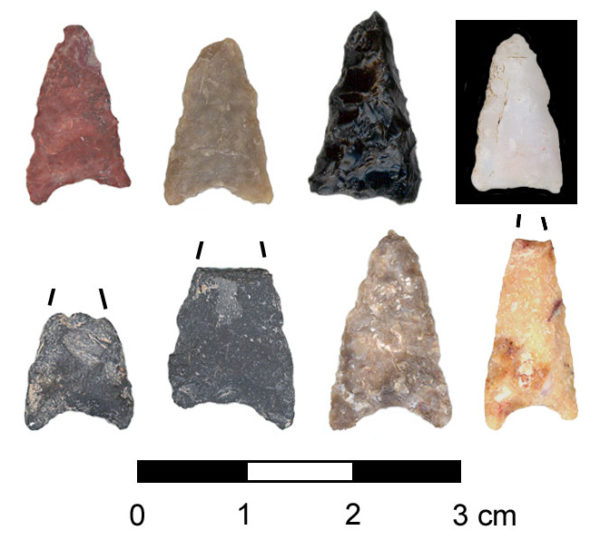
Piman points recovered from the Presidio San Agustín del Tucson (photo by R. J. Sliva).
Recently, a collection of artifacts from a dry cave in southern Arizona was given to Desert Archaeology, and among the items were a few Historic period points and several arrowshaft fragments. These examples reveals how the Piman points were affixed to arrow shafts. To attach the points to the arrows, people split or sawed notches into the ends of short, narrow sticks, and then inserted the point, probably with a dab of pitch or other adhesive, and then wrapped the end of the stick to secure it. This piece, called the foreshaft, could then be inserted into the end of a long, straight reed, forming a lightweight compound arrow. If the arrow point broke when it either hit the target or missed and hit the ground, the archer could easily re-arm the arrow by pulling out the foreshaft and inserting a new one with another point already attached.
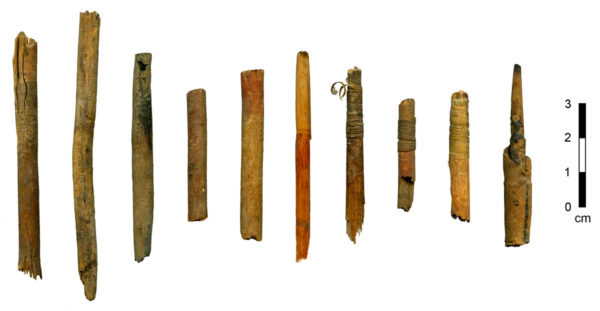
Historic-era arrow foreshaft fragments from a collection donated to Desert Archaeology. These are lightweight pieces of wood with diameters about half that of a standard yellow pencil. Sinew bindings, used to secure the arrow point into the split or slotted end of the foreshaft, are still present on the 2nd-4th pieces from the right. The rightmost foreshaft still has a sharpened wooden tip in place, with black resin used to adhesive still visible. Some of the foreshafts are painted (photo by R. J. Sliva).
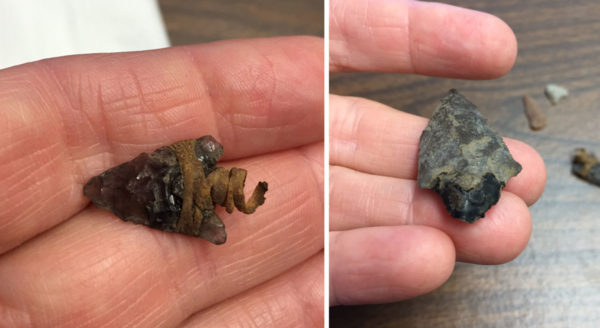
Two points from the collection donated to Desert Archaeology show different techniques of hafting (affixing to shafts). The point on the left, with the same concave-based design as the points from the Presidio San Agustín pictured above, was set into a slot at the end of a shaft and secured by wrapping a thin strip of sinew around the edges of the blade and down the shaft. The point on the right was designed with a protruding stem. This stem was dipped into heated pine pitch and jammed firmly into a sawed slot or drilled socket in the end of an arrowshaft. The pitch hardened as it cooled, holding the point in place (photo by R. J. Sliva).
Two excavations in Tucson have evidence of people being killed by arrows. Fieldwork conducted by Statistical Research in the early 1990s on historic Block 180 in downtown Tucson, at the northeast corner of W. Alameda Street and N. Church Avenue, located a grave containing the remains of two Mexican men. One of the men was between 18 and 20 years old. He had a projectile point embedded in the proximal end of the left sixth rib (the portion closest to the vertebral column). The arrow would have passed through the front of the chest and then through the major blood vessels above the heart, as well as the left lung. This undoubtedly killed this young man. The two men were probably found outside of Tucson and brought to the fort. However, they were not buried in the nearby Presidio cemetery. It is thought that since they were strangers, they were not allowed to be placed inside the consecrated Catholic cemetery.
Statistical Research also excavated the Alameda-Stone Cemetery (earlier known as the National Cemetery), at the northeast corner of E. Alameda Street and N. Stone Avenue. This work took place in 2007 and 2008 prior to the construction of the Pima County Consolidated Justice Court. The cemetery was used for civilian burials between the 1850s and 1875. Among the over 1,300 individuals discovered were two with projectile points. Grave Pit 3244 held three individuals buried in hexagonal coffins, apparently at the same time. The center person, Burial 3417b, was a 14- to 16-year-old European male with an arrow found in the right side of his body. It is uncertain whether the young man was killed by the arrow.
Another grave contained Burial 28544, a 30- to 50-year-old Hispanic male buried in a hexagonal coffin. He had a point embedded in his left femur, with no evidence for healing, and a second point in the cranium area. The man likely died from the wounds caused by the points. It was thought that this might be Jose Maria Martinez, who died in 1863 and who was known to have been wounded by arrows several years earlier. However, a DNA test was inconclusive.
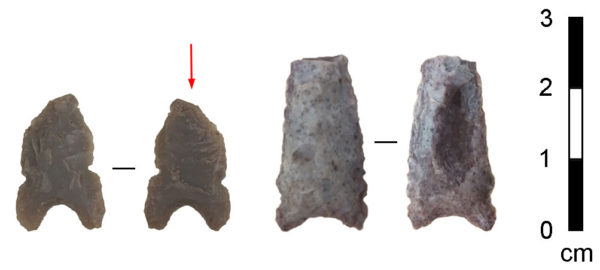
Two-sided views of arrow points recovered from the body of the individual in Burial 28544 in the Alameda-Stone Cemetery: in left femur (left), in cranium (right). Note the massive impact fracture on the left point (red arrow), where the force of the arrow striking bone chipped a large flake from one face of the point (photo by R. J. Sliva).
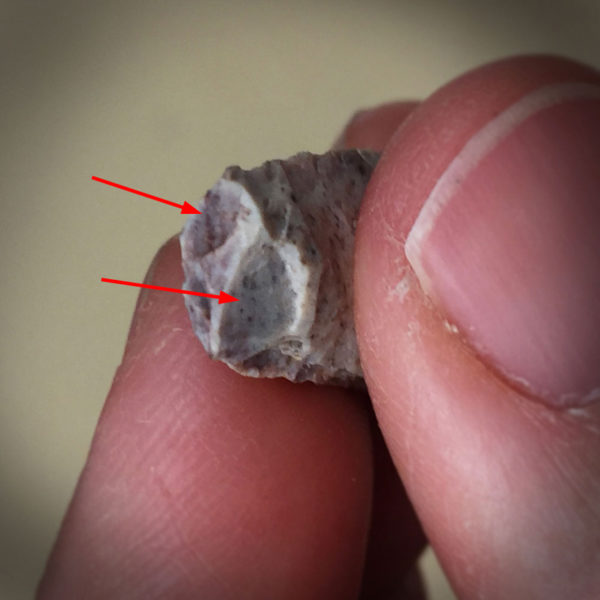
Closeup of the shattered tip of the point in the Burial 28544 individual’s cranium, with the ends of impact fractures visible (red arrows) (photo by R. J. Sliva).
Desert Archaeology has collected data on individuals who died in Tucson during the Territorial period (1856 to 1912). Newspaper accounts of deaths reveal that arrows continued to be used by Apache warriors as late as 1870. A couple of examples:
Another Overland Driver Shot. We learn from Mr. Anthony Elder, Conductor on the Overland line between here and Tucson, that the last coach from the West was attacked by a party of 40 or 50 Tonto Apaches about 45 miles the other side of that place. The driver was shot and probably killed as he fell from the box, and the seat was riddled with flint arrow heads (Mesilla Times, 13 April 1861, page 3, column 2).
A letter from Florence dated February 4th brings us accounts … in that section. On the 1st inst., a man named Diego CAMPIO, while on his way from Florence to Camp McDowell with a train of three wagons, laden with barley, was attacked by a large troop of Indians and was instantly killed. Mr. Campio when found had 44 arrows in various parts of his body besides a bullet wound which penetrated his brain. The sacks were emptied upon the ground and carried off; the mules were likewise all captured (The Weekly Arizonan, 12 February 1870, page 3, column 1).
The ongoing warfare between the United States Army and various Native American tribes led to many soldiers being struck by arrows. Army doctor J. H. Bill studied arrow wounds while stationed at Fort Craig in New Mexico and wrote the definitive article on their presentation and treatment for The American Journal of Medical Sciences in 1862. He invented a pair of forceps that were designed for the extraction of arrow heads, subsequently manufactured by the George Tiemann Company.

Forceps designed by Major J. H. Bill, U.S. Army, for arrow extraction in 1862.
By the mid-1860s, Native Americans in southern Arizona were acquiring firearms and the use of bow and arrows gradually ended, although they continued to be made by the O’odham into the 20th century. An O’odham bow and four arrows are on exhibit in the Our Peoples gallery at the National Museum of the American Indian in Washington, D.C.
Resources
Deathways and Lifeways in the American Southwest, Statistcal Research, Inc.’s series of reports on the Joint Courts Complex Archaeological Project: Volume 1, Volume 2, Volume 3


